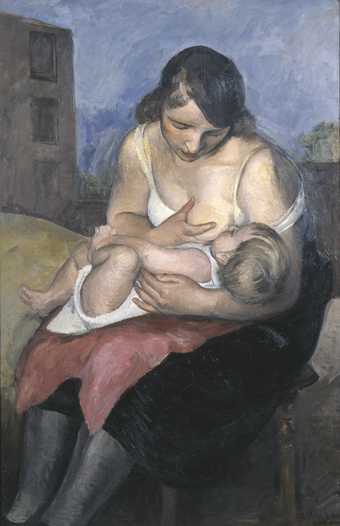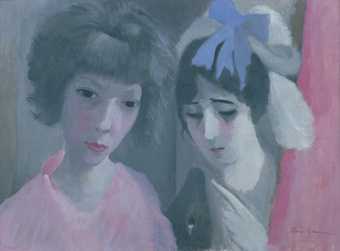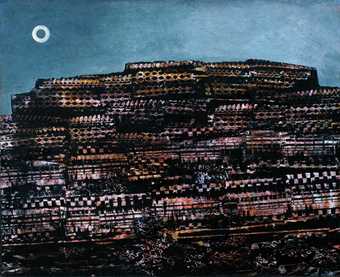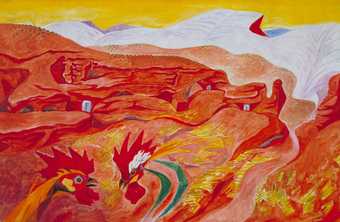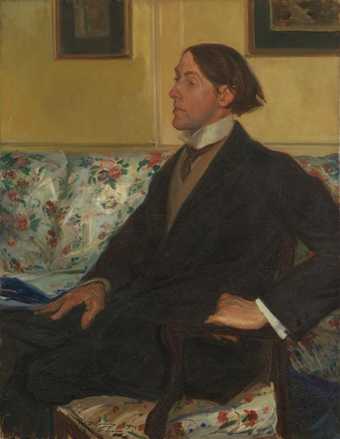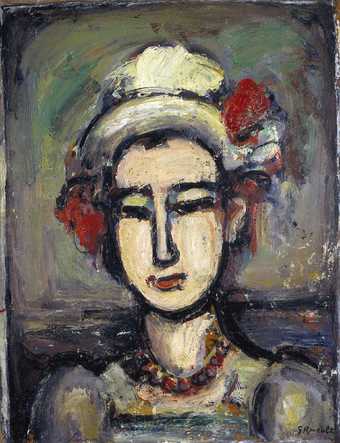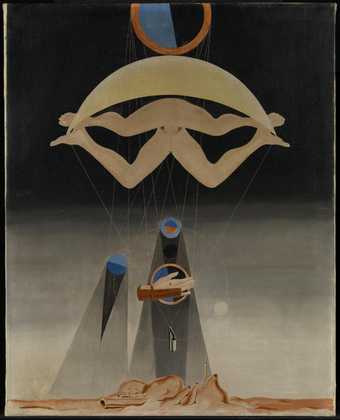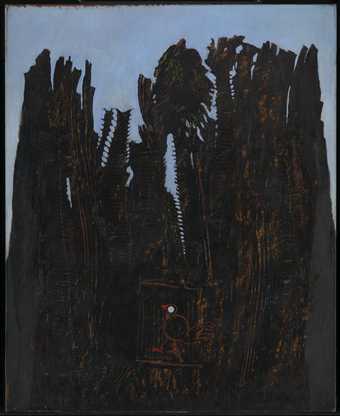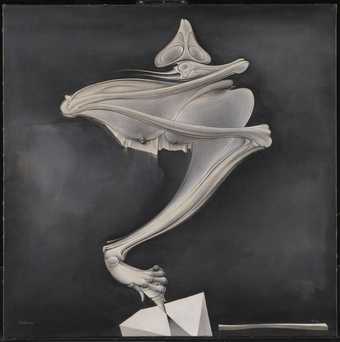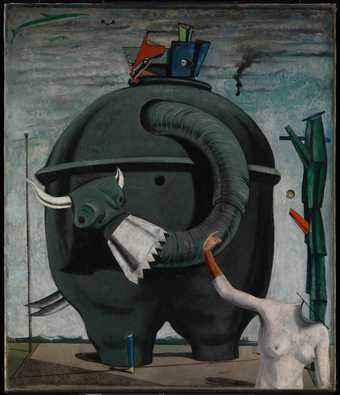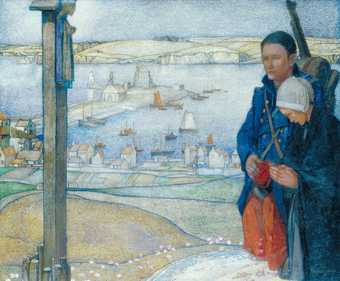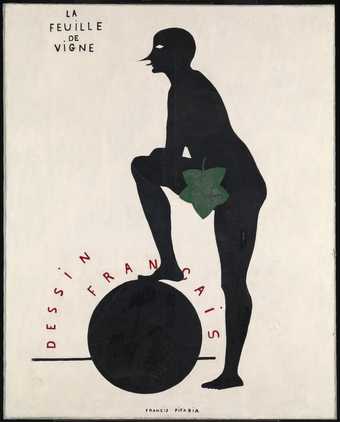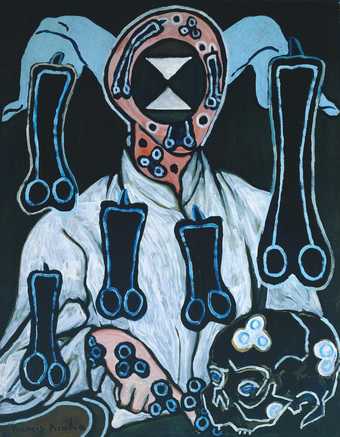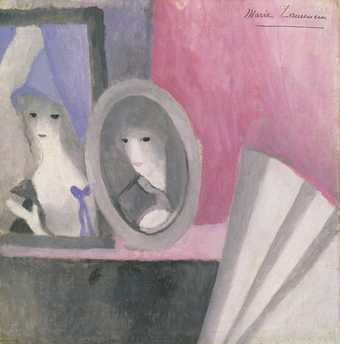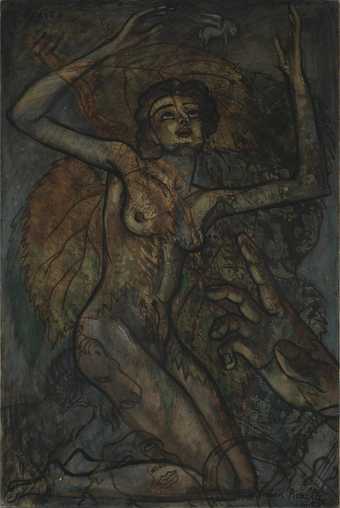
In Tate Modern
- Artist
- Francis Picabia 1879–1953
- Original title
- Le Beau Charcutier
- Medium
- Oil paint, 4 plastic combs and bone comb on canvas
- Dimensions
- Support: 924 × 737 × 22 mm
frame: 1060 × 870 × 55 mm - Collection
- Tate
- Acquisition
- Accepted by HM Government in lieu of tax and allocated to the Tate Gallery 1996
- Reference
- T07108
Summary
Painted in two separate periods, this picture has a complex history. In its original state, it showed a pink-faced man, wearing a white shirt and a black suit. It was painted in a deliberately simple, naive style, using household, rather than oil, paint, and incorporated various manufactured materials: string and short plastic combs were used in the man's hair, darning needles for the eybrows, toothpicks for the moustache and goatee beard, curtain rings for the eyes and mouth, measuring tape for the nose, and an array of pen-nibs in the area of the figure's bow-tie.
For some time the work was thought to belong to Picabia's Dada period (c.1915-21); indeed, the canvas is dated 1921 on the stretcher. However, the work appears to have been one of a group of paintings with collaged elements made between 1924 and 1926, in which Picabia lampooned traditional art and, through using everyday real objects, aimed to integrate the spheres of art and everyday life. Although many of these collage-paintings of the mid-1920s have been mistakenly antedated, experts now agree that, in comparison with earlier Dada works, they have much simpler subjects, are executed in a more direct and sensuous manner, and demonstrate a gentler humour.
It is possible that this work was intended as a satirical portrait of the prominent French intellectual and politician Raymond Poincaré, Member of the French Academy, President of the French Republic 1913-20 and Prime Minister in 1922-4 and 1926-9. Certainly, the painting was described as such in a letter of 1926 by the artist El Lissitzky who included the work in an exhibition he organised in Dresden in that year. (A photograph of the work as installed in this exhibition is reproduced in El Lissitzky 1890-1941: Retrospektive, exhibition catalogue, Sprengel Museum, Hanover, January-April 1988, p.48.) If this work was indeed a satirical portrait of Poincaré, Picabia may have intended the work to echo the sentiments expressed by the leader of the Surrealist movement André Breton who wrote in 1926: 'We consider the presence of M. Poincaré at the head of the French government to be a serious obstacle to all serious thought, an almost gratuitous insult to the spirit and a ferocious joke which should not be allowed to pass.' (quoted in Maria Lluïsa Borras, Picabia, London 1985, p.292). However, in 1927 the painting was exhibited at the Galerie Van Leer, Paris, simply as Portrait. It is therefore not clear how seriously or for how long Picabia himself regarded the work as a portrait of Poincaré.
By the time of the 1926 Dresden exhibition the work had acquired a distinctive frame made with sandpaper and corrugated cardboard. This was designed by Pierre Legrain, who made a number of unusual frames for Picabia in this period. In 1928 the painting and its frame were reproduced in the British periodical Artwork. An accompanying article commented on the work: 'Picabia's use of materials other than oil-paint, as in the portrait reproduced, with its combs, pins, etc., surely needs no defence. It is a trick, as oil-painting itself was a trick when first used. Constant renewal of technique is one of the principal means by which an artist escapes the prison of his own style, as much a necessity as escape from the prison of another's style.'
Some years later - it is not known exactly when - Picabia reworked the whole image. He pulled off all the collaged elements except the measuring tape, exposing in the process areas of bare canvas. He then painted the man's features in black, replicating the shapes of the original collaged elements, and stuck on new, larger combs in the area of the man's hair. Most dramatically, he painted in outline over the man's face the head and hands of a glamorous woman, with blue eyes and full red lips. Such overlapping of different images was a feature of Picabia's 'Transparency' paintings, the first of which date from the late 1920s. This technique allowed Picabia to create complex works, evocative at times of dream-like states of mind. In the case of this work, the two images of the man and the woman occupy the same space but nonetheless remain separate and incongruous.
It is known that this process of repainting was completed by mid-1935: a photograph of Picabia's studio, taken in the summer of that year, shows the work in its revised form but still with the original Legrain frame (now lost). Strangely, the work in its original state was reproduced in the French review XXe Siècle in May 1938, without its original frame and wrongly dated 1915. It acquired its present title by March 1949 when it was exhibited at the Galerie René Drouin, Paris.
With its layering of different images and combination of styles, The Handsome Pork-Butcher resists straightforward interpretation. To avoid the trap, as he saw it, of repeating himself, Picabia made many distinct shifts in style over his career, and chose to reinterpret and renew past work by repainting many of his old canvases. Two other paintings by Picabia in the Tate's collection, The Fig-Leaf, 1922, and Portrait of a Doctor, 1935-8, for example, were either totally or partially repainted. William Camfield, author of many texts on the artist, has described Picabia's decision to repaint this particular work as a dumbfounding, and essentially dadaist, 'act of self-liberation' (Francis Picabia: His Art, Life and Times, Princeton, New Jersey 1975, p.220).
Further reading:
William Camfield, Francis Picabia: His Art, Life and Times,
Princeton, New Jersey 1975
On page 220, note 16, Camfield writes that this painting was probably
exhibited in the 1927 show as 'Combs, Needles, Rubbers and Feathers'. The work
was reproduced in Artwork with this title, but this seems to have been
simply a mistake. The title has been attributed to another work (repr. Borràs
no.50), which, unlike this portrait, incorporated all these items, including
feathers.
Maria Lluïsa Borras, Picabia, London 1985
Jennifer Mundy
June 1997
Does this text contain inaccurate information or language that you feel we should improve or change? We would like to hear from you.
Display caption
The features of this pink-faced man were originally made up of collaged elements including string, measuring tape and curtain rings. Some years later, Picabia ripped these off, an action which also removed areas of paint, leaving patches of bare canvas visible. During the second phase of work, Picabia added combs for the hair, and painted in the head and hands of a woman. These dramatic alterations reflect Picabia’s humorous and irreverent approach to picture-making.
Gallery label, November 2005
Does this text contain inaccurate information or language that you feel we should improve or change? We would like to hear from you.
Technique and condition
Painted in oil paint on a fine linen canvas of a standard French size. It is primed with a light grey oil ground and thought to be attached to the stretcher with tacks, although these are hidden by canvas-backed strips of sand paper which are adhered to the tacking edges.
The original portrait was painted with a glossy, drying oil paint, likely to be a household paint such as Ripolin as used by Picabia at this time, onto which collaged elements were applied while the paint was still wet. The paint has wrinkled in places as a consequence of uneven drying between paint layers. In the later reworking of the portrait, the detachment of the collage material has exposed areas of bare canvas where the paint and ground layers have been removed. The replaced combs have been adhered to the paint surface with a discoloured adhesive which is visible on the surface and has penetrated through to the reverse of the canvas. Some original collage material - the string in the hair, bow-tie and measuring tape - remains embedded in the paint. The female portrait appears to have been painted in artists' oil paint in contrast with the earlier work. Later modifications by the artist to the black painted colour field overlap onto the attached sanded canvas strips, thereby suggesting that these were adhered to the edges of the canvas by the artist himself.
An uneven application of varnish has later been applied to revive sunken areas of paint. On acquisition a new frame was constructed, textured to imitate the strips along the painting's edges.
Jo Crook
June 1997
Explore
- emotions, concepts and ideas(16,416)
-
- universal concepts(6,387)
-
- ambiguity(310)
- clothing and personal items(5,879)
-
- comb(11)
- hand(602)
- head / face(2,497)
- individuals: male(1,841)
- trading and commercial(1,154)
-
- butcher(26)
You might like
-
Jean Marchand Maternity
1921 -
Marie Laurencin Portraits (Marie Laurencin, Cecilia de Madrazo and the Dog Coco)
1915 -
Max Ernst The Entire City
1934 -
André Masson Ibdes in Aragon
1935 -
Jacques-Émile Blanche Charles Conder
1904 -
Georges Rouault The Italian Woman
1938 -
Max Ernst Men Shall Know Nothing of This
1923 -
Max Ernst Forest and Dove
1927 -
Hans Bellmer Peg-Top
c.1937–52 -
Max Ernst Celebes
1921 -
Edward Reginald Frampton Brittany: 1914
c.1920 -
Francis Picabia The Fig-Leaf
1922 -
Francis Picabia Portrait of a Doctor
c.1935–8 -
Marie Laurencin The Fan
c.1919 -
Francis Picabia Otaïti
1930

